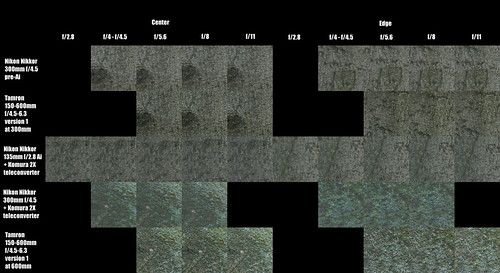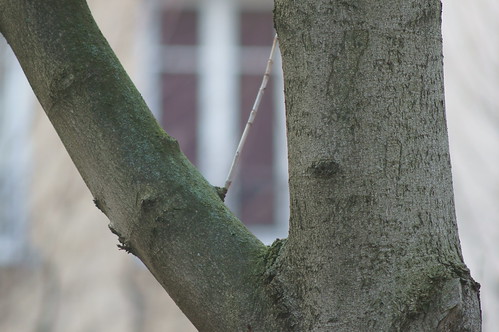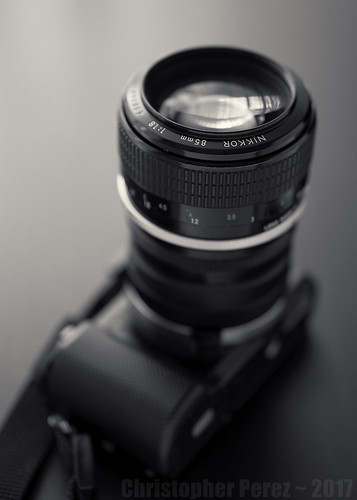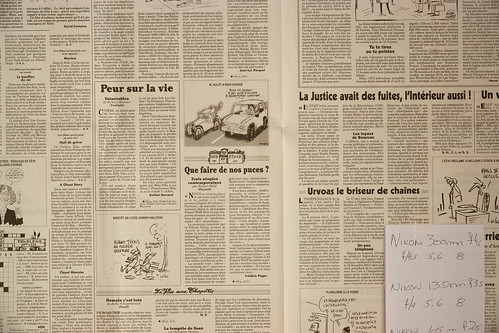Something that I've wondered out for many years is just how good or bad 2x teleconverters can be from back in the day.
Recently I stumbled on a Komura Telemore 2x teleconverter. It was relatively cheap and I was interested to see how it might perform.
Comparison Setup -
[If you click on the image it'll take you to the Flickr hosting site. Once there you and look at the file at full resolution. In many cases the differences between lenses is small and likely can't be seen until you take a squint at the image at 100 percent.]

Observations -
Looking at the Nikon Nikkor 300mm f/4.5 pre-Ai against the Tamron 150-600mm f/4.5-6.3 at 300mm shows not much difference between the two lenses in the center of the field. As you can see, the single coated Nikkor is slightly less contrasty than the modern Tamron. This can be easily corrected in processing by applying a gentle increase in contrast. The edges of the frame show something interesting. The Nikkor remains sharp where the Tamron gets slightly softer as the edge of the field is approached.
The Nikon Nikkor 135mm f/2.8 Ai mounted on the Komura Telemore 2x teleconverter shows that the Komura degrades performance rather rapidly. At no aperture does the teleconverted Nikkor come close to wither the un-teleconverted 300mm Nikkor nor the Tamron. Obvious decreases in contrast and resolution can be seen.
The same things can be said about the Nikkor 300mm, Komura Telemore combination. Contrast is decreased and the resolution never really matches the modern Tamron "Bigron" zoom. I can increase the contrast in processing, but there is no way to gain back resolution after the shutter has been tripped.
I was hoping to find a light(er) weight manual focus lens combination that I could use at the racetrack to photograph old cars and MotoGP motorcycles. I won't be able to meet that goal with the Komura and Nikkor lenses. For now I'll need to stay with the Tamron super zoom, which, it seems, performs admirably well.
Recently I stumbled on a Komura Telemore 2x teleconverter. It was relatively cheap and I was interested to see how it might perform.
Comparison Setup -
- Sony NEX-5T, 100ISO, 2 second timer, "A" aperture preferred mode
- Nikon Nikkor
- 300mm f/4.5 pre-Ai - two passes, one with and another without Komura Telemore 2x converter
- 135mm f/2.8 Ai + Komura Telemore 2x converter
- Tamron 150-600mm f/4.5-6.3 version 1 on Sony AF adapter
- Scene shot through double pane glass window (it was too damned cold to open the window for a clear shot)
Here is the scene at 300mm -
Here is the scene at 600mm -
Comparison Results -

Observations -
Looking at the Nikon Nikkor 300mm f/4.5 pre-Ai against the Tamron 150-600mm f/4.5-6.3 at 300mm shows not much difference between the two lenses in the center of the field. As you can see, the single coated Nikkor is slightly less contrasty than the modern Tamron. This can be easily corrected in processing by applying a gentle increase in contrast. The edges of the frame show something interesting. The Nikkor remains sharp where the Tamron gets slightly softer as the edge of the field is approached.
The Nikon Nikkor 135mm f/2.8 Ai mounted on the Komura Telemore 2x teleconverter shows that the Komura degrades performance rather rapidly. At no aperture does the teleconverted Nikkor come close to wither the un-teleconverted 300mm Nikkor nor the Tamron. Obvious decreases in contrast and resolution can be seen.
The same things can be said about the Nikkor 300mm, Komura Telemore combination. Contrast is decreased and the resolution never really matches the modern Tamron "Bigron" zoom. I can increase the contrast in processing, but there is no way to gain back resolution after the shutter has been tripped.
I was hoping to find a light(er) weight manual focus lens combination that I could use at the racetrack to photograph old cars and MotoGP motorcycles. I won't be able to meet that goal with the Komura and Nikkor lenses. For now I'll need to stay with the Tamron super zoom, which, it seems, performs admirably well.




